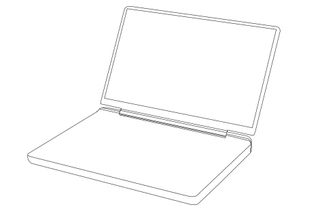GPD Win Max 2 Boasts Intel Alder Lake 14-Core CPU Upgrade
Not that bigger than its predecessor, thanks to ultra-narrow bezels.

GPD has officially announced the Win Max 2. The new design includes the transition from an 8 to a 10.1-inch screen and adopting a new Intel Alder Lake mobile processor with up to 14C/20T. It earns its 'Max' moniker in several ways; you will be able to buy this portable with up to 32GB of RAM, and it comes with up to 2TB PCIe 4.0 SSD in one of the two M.2 slots. All this attractive hardware resides inside an aluminum-magnesium alloy unibody chassis.
The previous-gen GPD Win Max came with an 8-inch screen with 1,280 x 800 pixels. With the Win Max 2, that screen jumps to a 1,920 x 1,200-pixel panel with a 10.1-inch diagonal. GPD says retro gamers will appreciate the screen aspect ratio. We think that the screen size inflation helps GPD to differentiate from the affordable and well-reviewed Steam Deck portable PC gaming machine with its 7-inch screen.
GPD says the new model is only growing from 207 × 145mm to 228 x 160mm despite this significant screen size change. Helping keep the size down are "ultra-narrow borders." The Hong Kong-based diminutive device specialist chose not to reveal the thickness of the new Win Max 2 at this time but says it is thinner. However, it might not know the exact thickness yet, judging from the basic sketch of the new device accompanying the blog post.

Another headlining change with the GPD Win Max 2 is the processor that arrives from one of Intel's new Alder Lake mobile lineup. GPD specifically mentions the Intel Core i7-1280P with 14 cores and 20 threads. This CPU boosts up to 4.80 GHz, has 24MB Smart Cache, and eats 20 and 64 watts.
The iGPU of the processor will be necessary for any non-cloud gaming on the Win Max 2. Intel's Iris Xe Graphics are present, with 96 EUs, and running at up to 1.45 GHz. With gamers pushing the high max TDP and CPU and iGPU on this gaming device, you may be concerned about the cooling. GPD says this new portable uses the same fan as the Win 3, which "ensures heat dissipation and quietness." We aren't sure if there will eventually be other processor options for buyers.
| Specifications |
GPD Win Max 2 |
|---|---|
|
Screen |
1,920 x 1,200 pixel with ultra-narrow borders |
|
Processor |
Intel Core i7-1280P with 14C/20T and Iris Xe Graphics |
|
RAM |
16GB or 32GB versions will be sold. Chipset supports up to 64GB |
|
Storage |
1TB or 2TB versions will be sold. The twin PCIe 4.0 M.2 slots support up to 8TB each. SD and microSD slots are present for up to a further 4TB storage. The SD slot offer up to 300 MB/s, and microSD up to 160 MB/s |
|
Ports |
Thunderbolt 4, 3x USB 3.2 Gen 2, |
|
Multimedia |
Built-in web cam, quad speaker surround sound |
|
Keyboard |
QWERTY keyboard with backlight and OC key |
|
Gaming control |
Sunken joystick using hall-effect tech, clickable joystick, motion controls, shoulder triggers, two other keys |
|
Other |
4G LTE, 65 Wh battery |
Overall, the GPD Win Max 2 is shaping quite a power-packed 10.1-inch portable. The processor side of things looks good, but the iGPU isn't the best for modern games. GPD must realize this and doesn't forget to pitch this portable as also being capable as a highly mobile "office notebook." However, the previous generation came with both Intel and AMD processor options, which are often much better at gaming. The company may repeat the dual-processor product strategy, but we don't know at this early stage.
We don't have essential information about the new GPD Win Max 2, such as availability and pricing. It would also be good to get some product renders, photos, or videos, but we are obviously at a stage in development too early.
Stay On the Cutting Edge: Get the Tom's Hardware Newsletter
Get Tom's Hardware's best news and in-depth reviews, straight to your inbox.

Mark Tyson is a Freelance News Writer at Tom's Hardware US. He enjoys covering the full breadth of PC tech; from business and semiconductor design to products approaching the edge of reason.
-
Giroro Well it looks like Intel got what they wanted. There's no longer any attempt whatsoever to differentiate big Cores from little cores.Reply
They're just all being treated like one big misleading pool of equivalent "14-Cores". -
rluker5 As somebody who has played a few games on my 12700k using different windows power plans, I would really like to see the effect of using "power saver" vs "balanced" in gaming with a very power restricted device like this. Power saver puts the E-cores in the driver's seat, noticeably reduces performance and increases hitching, but drastically lowers cpu power consumption leaving much more budget for the igpu.Reply
It would be easy for an end user to do and hopefully is easy to review.
Setting a custom power plan with a max processor state of 99% (disables boost) also does this to a lesser extent, but Alder has better options. -
TerryLaze Reply
This is going to be three times the price of the steam deck, or the previous version was, this might be even more expensive.excalibur1814 said:Steam Deck is this, Steam Deck is that.
Yeah. Okay. It'll soon be left behind.
So the steam deck is still going to be this and that and everything because people will actually be able to afford it.
Most Popular




